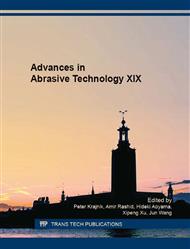p.97
p.101
p.109
p.115
p.127
p.133
p.139
p.145
p.151
Effect of Media Degradation on Finishing Characteristics in Abrasive Flow Machining
Abstract:
Abrasive flow machining (AFM) is one of the most promising technologies for internal finishing and de-burring for features with complex geometry. This study investigates the effect of media degradation on finishing characteristics achieved using the AFM process. A total of 50 experiments, using Inconel 718 cylindrical coupons machined by Wire-Electron Discharge Machining (WEDM), were conducted employing the same process conditions while using a single batch of AFM media. Experimental results indicate that media degradation has minor influence on surface roughness, but more significant influence on material removal and media flow rate. Material removal decreases exponentially with increasing cumulative media flow volume despite media flow rate increasing. There is a linear correlation between material removal and media flow rate. As a result, material removal can be estimated from media flow rate which can be monitored easily.
Info:
Periodical:
Pages:
127-132
Citation:
Online since:
October 2016
Price:
Сopyright:
© 2016 Trans Tech Publications Ltd. All Rights Reserved
Share:
Citation:


